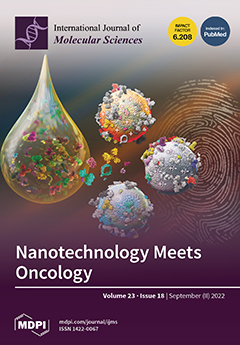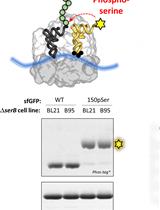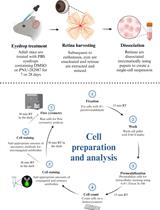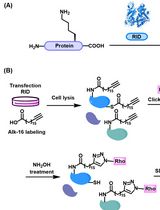- EN - English
- CN - 中文
A Modified Acyl-RAC Method of Isolating Retinal Palmitoyl Proteome for Subsequent Detection through LC-MS/MS
一种改良的酰基-RAC方法分离视网膜棕榈酰蛋白质组,并通过LC-MS/MS进行后续检测
发布: 2023年04月20日第13卷第8期 DOI: 10.21769/BioProtoc.4654 浏览次数: 2559
评审: Ansul LokdarshiRicardo Urquidi Camacho
Abstract
Palmitoylation is a unique and reversible posttranslational lipid modification (PTM) that plays a critical role in many cellular events, including protein stability, activity, membrane association, and protein–protein interactions. The dynamic nature of palmitoylation dictates the efficient sorting of various retinal proteins to specific subcellular compartments. However, the underlying mechanism through which palmitoylation supports efficient protein trafficking in the retina remains unclear. Recent studies show that palmitoylation can also function as a signaling PTM, underlying epigenetic regulation and homeostasis in the retina. Efficient isolation of retinal palmitoyl proteome will pave the way to a better understanding of the role(s) for palmitoylation in visual function. The standard methods for detecting palmitoylated proteins employ 3H- or 14C-radiolabeled palmitic acid and have many limitations, including poor sensitivity. Relatively recent studies use thiopropyl Sepharose 6B resin, which offers efficient detection of palmitoylated proteome but is now discontinued from the market. Here, we describe a modified acyl resin–assisted capture (Acyl-RAC) method using agarose S3 high-capacity resin to purify palmitoylated proteins from the retina and other tissues, which is greatly compatible with downstream processing by LC-MS/MS. Unlike other palmitoylation assays, the present protocol is easy to perform and cost-effective.
Graphical overview

Background
The retina is a thin layer of neural tissue lining the back of the eye, containing six different cell types organized together for visual perception. Vision is initiated through retinal photoreceptors, which are polarized and compartmentalized neurons containing ciliated outer segments (OS). Photoreceptor OS contains thousands of double membranous discs that harbor phototransduction proteins, which are responsible for capturing light and converting it into an electrical signal. The OS discs, along with the proteins that mediate phototransduction within the ciliated structures, are phagocytized in a circadian rhythm by pigmented epithelial cells that abut the retinal layer. On the basal side of the photoreceptor neurons lay the ribbon synapses that are responsible for the transmission of light-dependent electrical signals to downstream neurons, which ultimately transmit the signals to the visual cortex. The proteins present at the synapse and in the OS disc membranes are synthesized in the inner segment (IS) of the photoreceptor neurons and trafficked to their destination. The constant renewal of the OS discs necessitates continual protein synthesis and efficient sorting machinery (Burns and Arshavsky, 2005; Baker et al., 2008).
The protein trafficking machinery in photoreceptor neurons is greatly aided by the lipid modification of proteins (Kolandaivelu et al., 2009;Maeda et al., 2010;Yang and Wensels, 1992). Among the lipid modifications, palmitoylation is the most common form of protein acylation, which adds a 16-carbon palmitic acid to a cysteine residue in the protein. Unlike most lipid modifications, palmitoylation is unique and reversible, and therefore plays a dynamic role in dictating the localization of a protein both spatially and temporally. Defects in the sorting of proteins due to the absence/loss of palmitoylation have been associated with various inherited blinding diseases, suggesting an important role of this lipid modification. Several studies including ours described the importance of palmitoylation in retinal health and function. We showed that lack of palmitoylation in a retinitis pigmentosa–associated protein—progressive rod-cone degeneration (PRCD)—leads to protein mistargeting to the photoreceptor IS where it undergoes severe destabilization (Murphy and Kolandaivelu, 2016). Likewise, mutating palmitoylation sites in rhodopsin leads to severe light-induced photoreceptor degeneration (Maeda et al., 2010). However, a paucity of information on retinal palmitoylated proteins hinders our progress toward understanding the significance of this crucial modification in retinal structure and function. Our modified acyl resin–assisted capture (Acyl-RAC) method efficiently identifies the global palmitoyl proteome in retinal neurons and other tissues that are compatible with downstream mass spectrometry (LC-MS/MS) analyses for further validation (Forrester et al., 2011;Murphy and Kolandaivelu, 2016; Myers et al., 2022). Using our protocol, we show the efficient isolation of palmitoylated proteins and downstream validation of known palmitoylated proteins by immunoblotting. Using this protocol, we show that several proteins that are critical for proper retinal function, and proteins linked with blinding diseases, are post-translationally lipid-modified by palmitoylation. Additionally, we show that our protocol can be reliably used to identify palmitoylated proteins in other tissues.
Materials and Reagents
Eppendorf 1.5 mL tubes (Thermo Fisher Scientific, catalog number: 05-408-129)
1 M HEPES, pH 7.5 (Thermo Fisher, catalog number: 15630080)
5 M NaCl (Thermo Fisher Scientific, catalog number: 00622643)
500 mM EDTA (Thermo Fisher Scientific, catalog number: AM9260G)
Sodium dodecyl sulfate (SDS) (Sigma-Aldrich, catalog number: 8170341000)
Hydroxylamine-HCl (Thermo Fisher Scientific, catalog number: 270100010)
Pierce protease inhibitor tablet, EDTA free (Thermo Fisher Scientific, catalog number: A32955)
Phosphatase inhibitor (Thermo Fisher Scientific, catalog number: J63907.AA)
HDSF (Santa Cruz, catalog number: sc-221708A)
Methyl methanethiosulfonate (MMTS) (Sigma-Aldrich, catalog number: 2949920)
100% acetone (Thermo Fisher Scientific, catalog number: 186947)
2-Mercaptoethanol (β-ME) (Calbiochem, catalog number: UN2966)
1 M dithiothreitol (DTT) (Sigma-Aldrich, catalog number: D0632)
Agarose S3 high-capacity acyl-RAC capture resin (Nanocs, catalog number: AR-SS-2)
0.5 M Tris-HCl, pH 6.8 (Thermo Fisher Scientific, catalog number: J63735.K2)
100% glycerol (Thermo Fisher Scientific, catalog number: 15548224)
Bromophenol blue (Sigma-Aldrich, catalog number: B5525)
3 kD cutoff centrifugal filter (Millipore, catalog number: Z677094)
Trichloroacetic acid (TCA) (Thermo Fisher Scientific, catalog number:184151000)
Coomassie stain (Bio-Rad, catalog number:1610786)
Triton X-100 (Sigma-Aldrich, catalog number: 9036195)
Sodium hydroxide (NaOH) (Thermo Fisher Scientific, catalog number: A16037.36)
Lysis buffer base (see Recipes)
Lysis buffer – working solution (see Recipes)
Binding buffer (see Recipes)
Blocking buffer (see Recipes)
5× Laemmli sample buffer (see Recipes)
1× Laemmli sample buffer (see Recipes)
1 M dithiothreitol (DTT) (see Recipes)
100% TCA stock preparation (w/v) (see Recipes)
Tris-glycine SDS running buffer (Thermo Fisher Scientific, catalog number: LC26755) (see Recipes)
70% acetone (see Recipes)
2 M hydroxylamine (see Recipes)
2 M sodium chloride (see Recipes)
5 M sodium hydroxide (See Recipes)
10% Triton X-100 (see Recipes)
Equipment
Sonicator (Fisher, Microson Ultrasonic cell disruptor, model: CL-18)
Heat block (Thermo Fisher Scientific, catalog number: 11715125D)
Vortex (Scientific Industries, model: G-560)
Centrifuge, (Eppendorf, catalog number: 0011627)
Nutator (Thermo Fisher Scientific, model: 88881001)
Software
Excel 2016 (Microsoft)
GraphPad Prism (Version 9.0)
Adobe Illustrator 2023
CSS-Palm 4.0 – Palmitoylation Sites Prediction tool (Ren et al., 2008)
Procedure
文章信息
版权信息
© 2023 The Author(s); This is an open access article under the CC BY-NC license (https://creativecommons.org/licenses/by-nc/4.0/).
如何引用
Motipally, S. I., Myers, B., Sechrest, E. R., Sokolov, D., Murphy, J. and Kolandaivelu, S. (2023). A Modified Acyl-RAC Method of Isolating Retinal Palmitoyl Proteome for Subsequent Detection through LC-MS/MS. Bio-protocol 13(8): e4654. DOI: 10.21769/BioProtoc.4654.
分类
生物化学 > 蛋白质 > 翻译后修饰
神经科学 > 感觉和运动系统 > 视网膜
您对这篇实验方法有问题吗?
在此处发布您的问题,我们将邀请本文作者来回答。同时,我们会将您的问题发布到Bio-protocol Exchange,以便寻求社区成员的帮助。
Share
Bluesky
X
Copy link













